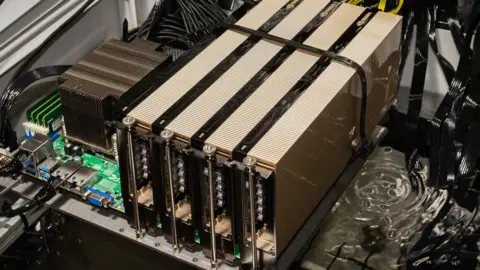Tiny data centre used to heat public swimming pool
The heat generated by a washing-machine-sized data centre is being used to heat a Devon public swimming pool.
The computers inside the white box are surrounded by oil to capture the heat - enough to heat the pool to about 30C 60% of the time, saving Exmouth Leisure Centre thousands of pounds.
The data centre is provided to the council-run centre free of charge.
Start-up Deep Green charges clients to use its computing power for artificial intelligence and machine learning.
Founder Mark Bjornsgaard said the company would also refund the leisure centre's electricity costs for running the "digital boiler" - and seven other England pools had signed up to the scheme.
The concept, developed over five years, is relatively straight forward - the hot oil is pumped into a heat exchanger to warm the water in the pool.
Sean Day, who runs the leisure centre, said he had been expecting its energy bills to rise by £100,000 this year.
"The partnership has really helped us reduce the costs of what has been astronomical over the last 12 months - our energy prices and gas prices have gone through the roof," he said.
"Looking at different ways of how we can save money as an organisation has been awesome."
Swim England chief executive Jane Nickerson said it was good to see pools "embracing innovative solutions".
Last summer, BBC News revealed 65 swimming pools had closed since 2019, with rising energy costs cited as a significant reason.
'Huge problem'
Cambridge University professor of engineering and the environment Dr Julian Allwood said: "If it's a sensible idea and it saves the leisure centre some money, then why not?" adding data centres on the whole used less energy than previously reported.
But large ones can require billions of gallons of water and millions of pounds to keep cool.
Some are even built under water - or in caves or very cold parts of the world.
And in Danish and Swedish cities, huge data centres power thousands of homes.
"Data centres have got a huge problem with heat," Mr Bjornsgaard said.
"A lot of the money that it costs to run a data centre is taken up in getting rid of the heat.
"And so what we've done is taken a very small bit of a data centre to where the heat is useful and required."


